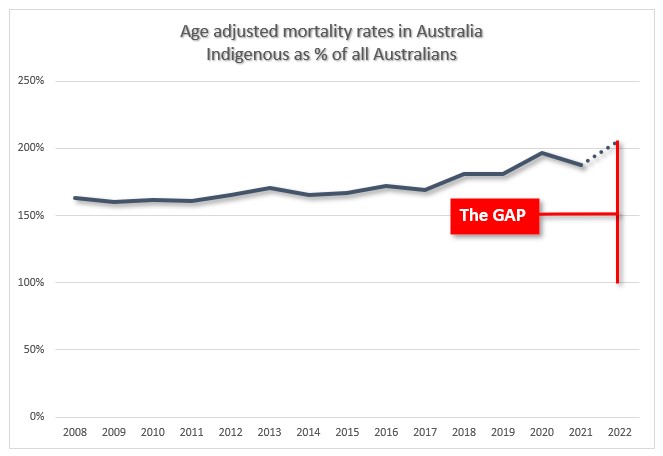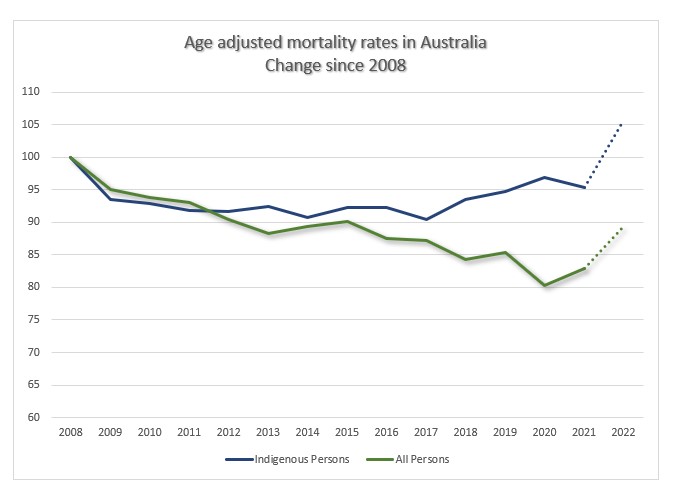I’m going to be voting Yes in the referendum about the Voice to Parliament. Making decisions about people without giving them a say is not a great way to make great decisions. And it hasn’t worked.
To illustrate, I’m going to talk about a measure I do know a lot about – mortality. The life expectancy of indigenous people in Australia is much lower than for all Australians. And the gap is growing.
I’ve updated my previous analysis with an extra year of statistics, and it’s worse. Since 2008, Australian Governments have set targets for areas where they aim to close the gap between indigenous and non indigenous people. The first measure is life expectancy. But the gap is growing, not narrowing.
 What I’ve shown in this graph is the age adjusted mortality rate for Indigenous people as a % of the age adjusted mortality rate for all Australians. In 2008, mortality for Indigenous Australians was 163% of the mortality for all Australians. And in 2022, the gap had widened so that indigenous mortality was 205% of mortality for all Australians. An indigenous person is more than twice (2.05 times) as likely to die in the next year as an average Australian of the same age and gender.
What I’ve shown in this graph is the age adjusted mortality rate for Indigenous people as a % of the age adjusted mortality rate for all Australians. In 2008, mortality for Indigenous Australians was 163% of the mortality for all Australians. And in 2022, the gap had widened so that indigenous mortality was 205% of mortality for all Australians. An indigenous person is more than twice (2.05 times) as likely to die in the next year as an average Australian of the same age and gender.
 Another way of looking at this picture is to look at the change in mortality from a common starting point – and what you can see here is that mortality has improved overall for all Australians, but for indigenous people it improved (more slowly) for a while, but then it is actually worse than where it started in 2008.
Another way of looking at this picture is to look at the change in mortality from a common starting point – and what you can see here is that mortality has improved overall for all Australians, but for indigenous people it improved (more slowly) for a while, but then it is actually worse than where it started in 2008.
That gap is not closing, it is getting wider. What we’re doing in Australia to close the gap isn’t working, it’s time to change, and that means voting Yes to the voice for a new approach where indigenous people have a say in their own lives.
A word on data
As an overall measure of the health of a population, life expectancy at birth is one of the best individual numbers, as it captures so many aspects of health of a population, and in general, the data is more certain. You might wonder why am I looking at mortality rates rather than life expectancy? Its because the most recent life expectancy calculation for indigenous Australians was some time ago – it reflects mortality from 2015-2017. The gap then was 7.8 years. It is almost certainly bigger now.
However when looking at the mortality of any subset of a population (in this case indigenous people), it is very important that the numerator (deaths) matches the denominator (population). That is very difficult to do, as it depends on the death certificate and the census (which are the main sources of information in this case) having matching likelihoods of capturing someone’s indigenous status. The ABS has done a lot of work on this matching process, (described here in the CDE project report) but it is imperfect, and sitting in on one conversation about how difficult it is reminded me how important it is to have people from the community themselves being involved in this kind of work. This process was updated for NSW for 2022, described here and I’ve allowed for the change in measurement in my trend analysis.
Useful Sources
- Latest information comes from the report on mortality for 2022 here from the ABS.
- Earlier mortality measures come from the 2017 report here from the ABS into Leading causes of death in Aboriginal and Torres Straight Islander people
- The AIHW had a close look at trends in this report from 2001 – 2015 (although the numbers aren’t completely comparable, given slightly different definitions)
- Anothe report from the AIHW looks at life expectancy to 2011
- The most recent report into Aboriginal life expectancy is from the ABS in 2018, showing a gap for Australia as a whole of 7.8 years


Thanks, Jennifer. I’ve taken the liberty of sharing your charts on a couple of neighbourhood forums in which I’m participating – and a link to “The Eye”. Sadly, I suspect many on those forums are immune to quality information. I’ve already voted (out of state and in the back blocks on voting day). No prizes for guessing my vote.
Thank you Jennifer for another enlightening, but sobering article. I voted yes at an early voting centre in St Leonards. I cannot understand why anyone would vote no.